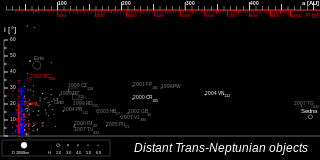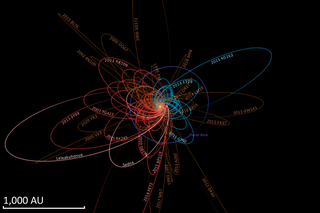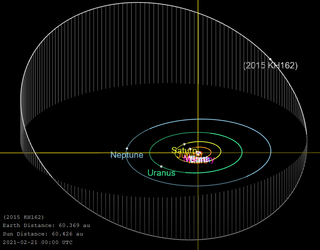A trans-Neptunian object (TNO), also written transneptunian object, is any minor planet in the Solar System that orbits the Sun at a greater average distance than Neptune, which has an orbital semi-major axis of 30.1 astronomical units (AU).

The scattered disc (or scattered disk) is a distant circumstellar disc in the Solar System that is sparsely populated by icy small Solar System bodies, which are a subset of the broader family of trans-Neptunian objects. The scattered-disc objects (SDOs) have orbital eccentricities ranging as high as 0.8, inclinations as high as 40°, and perihelia greater than 30 astronomical units (4.5×109 km; 2.8×109 mi). These extreme orbits are thought to be the result of gravitational "scattering" by the gas giants, and the objects continue to be subject to perturbation by the planet Neptune.

(612911) 2004 XR190, informally nicknamed Buffy, is a trans-Neptunian object, classified as both a scattered disc object and a detached object, located in the outermost region of the Solar System. It was first observed on 11 December 2004, by astronomers with the Canada–France Ecliptic Plane Survey at the Mauna Kea Observatories, Hawaii, United States. It is the largest known highly inclined (> 45°) object. With a perihelion of 51 AU, it belongs to a small and poorly understood group of very distant objects with moderate eccentricities.
(118228) 1996 TQ66 (provisional designation 1996 TQ66) is a resonant trans-Neptunian object of the plutino population in the Kuiper belt, located in the outermost region of the Solar System. It was discovered on 8 October 1996, by American astronomers Jun Chen, David Jewitt, Chad Trujillo, and Jane Luu, using the UH88 telescope at the Mauna Kea Observatories, Hawaii. The very red object measures approximately 185 kilometers (110 miles) in diameter. As of 2021, it has not been named.
(35671) 1998 SN165 (provisional designation 1998 SN165) is a trans-Neptunian object from the Kuiper belt located in the outermost region of the Solar System. It was discovered on 23 September 1998, by American astronomer Arianna Gleason at the Kitt Peak National Observatory near Tucson, Arizona. The cold classical Kuiper belt object is a dwarf planet candidate, as it measures approximately 400 kilometers (250 miles) in diameter. It has a grey-blue color (BB) and a rotation period of 8.8 hours. As of 2021, it has not been named.

Detached objects are a dynamical class of minor planets in the outer reaches of the Solar System and belong to the broader family of trans-Neptunian objects (TNOs). These objects have orbits whose points of closest approach to the Sun (perihelion) are sufficiently distant from the gravitational influence of Neptune that they are only moderately affected by Neptune and the other known planets: This makes them appear to be "detached" from the rest of the Solar System, except for their attraction to the Sun.

(612584) 2003 QX113 is a large trans-Neptunian object from the scattered disc located in the outermost region of the Solar System. It is one of the most distant objects from the Sun at 60.5 AU. It was discovered by astronomers with the Canada–France Ecliptic Plane Survey at Mauna Kea Observatories, Hawaii, when it was near aphelion on 31 August 2003. It was provisionally designated 2003 QX113.
(589683) 2010 RF43 (provisional designation 2010 RF43) is a large trans-Neptunian object orbiting in the scattered disc in the outermost regions of the Solar System. The object was discovered on 9 September 2010, by American astronomers David Rabinowitz, Megan Schwamb and Suzanne Tourtellotte at ESO's La Silla Observatory in northern Chile.
(445473) 2010 VZ98 (provisional designation 2010 VZ98) is a trans-Neptunian object of the scattered disc, orbiting the Sun in the outermost region of the Solar System. It has a diameter of approximately 400 kilometers.

An extreme trans-Neptunian object (ETNO) is a trans-Neptunian object orbiting the Sun well beyond Neptune (30 AU) in the outermost region of the Solar System. An ETNO has a large semi-major axis of at least 150–250 AU. The orbits of ETNOs are much less affected by the known giant planets than all other known trans-Neptunian objects. They may, however, be influenced by gravitational interactions with a hypothetical Planet Nine, shepherding these objects into similar types of orbits. The known ETNOs exhibit a highly statistically significant asymmetry between the distributions of object pairs with small ascending and descending nodal distances that might be indicative of a response to external perturbations.

(674118) 2015 KH162 is a large trans-Neptunian object orbiting in the scattered disc region of the outermost Solar System. First observed in 2015, this minor planet is one of the most distant objects from the Sun at 60.6 AU, or twice as far as Neptune.
2003 SS422 is a trans-Neptunian object located in the outermost region of the Solar System. It was discovered on 28 September 2003, by American astronomers at the Cerro Tololo Observatory in La Serena, Chile, and estimated to measure approximately 168 kilometers (104 miles) in diameter.
2014 FZ71 is a trans-Neptunian object, a scattered disc classified as a scattered and detached object, located in the outermost region of the Solar System. It was first observed on 24 March 2014, by a team led by American astronomer Scott Sheppard at the Cerro Tololo Inter-American Observatory in Chile. With its perihelion of almost 56 AU, it belongs to a small and poorly understood group of very distant objects with moderate eccentricities. The object is not a dwarf planet candidate as it only measures approximately 150 kilometers (93 miles) in diameter.
(690420) 2014 FC72 is a trans-Neptunian object, classified as a scattered and detached object, located in the outermost region of the Solar System. It was first observed on 24 March 2014 by astronomers with the Pan-STARRS survey at Haleakala Observatory, Hawaii, United States. With its perihelion distant from Neptune, it belongs to a small and poorly understood group of objects with moderate eccentricities. It is estimated to measure 500 kilometers (300 miles) in diameter, assuming a low albedo.
2015 FJ345 is a trans-Neptunian object and detached object, located in the scattered disc, the outermost region of the Solar System. It was first observed on 17 March 2015, by a team led by American astronomer Scott Sheppard at the Mauna Kea Observatories, in Hawaii, United States. With its perihelion of almost 51 AU, it belongs to a small and poorly understood group of very distant objects with moderate eccentricities. The object is not a dwarf planet candidate as it only measures approximately 120 kilometers (75 miles) in diameter.
2015 KQ174 is a trans-Neptunian object, both considered a scattered and detached object, located in the outermost region of the Solar System. The object with a moderately inclined and eccentric orbit measures approximately 154 kilometers (96 miles) in diameter. It was first observed on 24 May 2015, by astronomers at the Mauna Kea Observatories in Hawaii, United States.
(523635) 2010 DN93 (provisional designation 2010 DN93) is a trans-Neptunian object from in the scattered disc located in the outermost region of the Solar System. It was discovered on 26 February 2010, by astronomers with the Pan-STARRS survey at Haleakala Observatory on the island of Maui, Hawaii, in the United States. Assuming a low albedo, the object is estimated at 490 kilometers (300 miles) in diameter. It was numbered in 2018 and remains unnamed.

2013 FQ28 is a trans-Neptunian object, both considered a scattered and detached object, located in the outermost region of the Solar System. It was first observed on 17 March 2013, by a team of astronomers at the Cerro Tololo Inter-American Observatory in Chile. It orbits the Sun in a moderate inclined, moderate-eccentricity orbit. The weak dwarf planet candidate measures approximately 260 kilometers (160 miles) in diameter.
2013 SK100 is a trans-Neptunian object, both considered a scattered and detached object, located in the outermost region of the Solar System. The object with a moderately inclined and eccentric orbit measures approximately 135 kilometers (84 miles) in diameter. It was first observed on 29 September 2013, by astronomers at the Mauna Kea Observatories in Hawaii, United States.
2014 ST373 (prov. designation:2014 ST373) is a trans-Neptunian object and a detached object from the outermost region of the Solar System. With a perihelion of 50.2 AU, it belongs to the top 10 minor planets with the highest known perihelia of the Solar System. and is neither a scattered disc nor an extreme trans-Neptunian object. It measures approximately 370 kilometers (230 miles) in diameter and was first observed on 25 September 2014, by astronomers using the Dark Energy Camera (DECam) at Cerro Tololo Inter-American Observatory in Chile.









